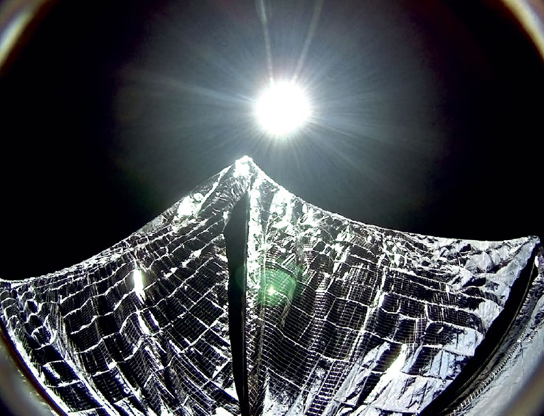2015
LightSail-1
James Clerk Maxwell (1831–1879), Konstantin Tsiolkovsky (1857–1935)
Early astronomers noticed that the tails of many bright comets pointed away from the Sun, suggesting that there might be some sort of wind streaming between the planets. It wasn’t until the nineteenth century, however, that physicists like James Clerk Maxwell could explain the effect: light carries momentum and thus exerts a sort of pressure on objects in space. Early-twentieth-century Russian rocketry pioneer Konstantin Tsiolkovsky was among the first to suggest using solar radiation pressure as a way to propel spacecraft. For most of the history of rocketry, however, the idea of “solar sailing” was mostly relegated to science fiction.
Serious efforts to design and deploy solar sails for space missions began to be considered in the 1990s, but it wasn’t until 2010 that the first interplanetary solar sail was successfully deployed, by the Japanese space agency’s experimental spacecraft, IKAROS (Interplanetary Kite-craft Accelerated by Radiation Of the Sun). IKAROS successfully showed that a spacecraft’s orientation and acceleration could be controlled in deep space using a solar sail.

Artist’s rendering of the Japanese IKAROS solar-sail mission.
Much closer to home, in 2015 a public space-advocacy organization, called the Planetary Society, succeeded in deploying the first privately funded solar sail in low-Earth orbit, using a tiny and relatively low-cost CubeSat spacecraft. The mission, called LightSail-1, was designed to test solar sail technologies and deployment methods in advance of a more extensive test of actual controlled solar sail propulsion. That follow-on mission is scheduled to be LightSail-2.
Solar sails, powered by sunlight or potentially even lasers, are widely regarded as a viable future propulsion method for interplanetary and even interstellar travel. The IKAROS and LightSail missions are setting the stage for much more ambitious efforts. Indeed, as Johannes Kepler wrote to Galileo back in 1610, “Provide ships or sails adapted to the heavenly breezes, and there will be some who will brave even that void.”
SEE ALSO End of the Ether (1887), Liquid-Fueled Rocketry (1926), “Great Comet” Hale-Bopp (1997).
A fish-eye lens self-portrait of part of the solar sail deployed in low Earth orbit by the Planetary Society’s LightSail-1 CubeSat mission, on June 8, 2015. The square sail is a little over 18 feet (6 meters) on a side.
